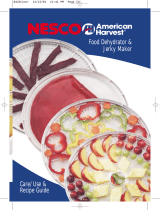
10 11
◆ To save nutrients and produce a quality product, it is necessary to work
fast preparing foods to dry. When placed in your dehydrator, they need to
dry continuously at the recommended temperatures and times. Do not
turn o your dehydrator or leave partially dried food on the trays as it may
spoil or develop “o” flavors.
◆ Spread all foods evenly to dry in single layers. Do not overlap.
◆ Do not add fresh produce to a partially dried batch. It will slow the rate of
drying for both products. It is possible, however, to combine partially dried
foods on to fewer trays.
◆ Many people have more than one NESCO
®
dehydrator. If you have two, it’s
easy to combine a load from both dehydrators after a few hours and start
a new batch in your second dehydrator using the remaining trays.
Selecting Foods To Dry
Select the best quality produce at the peak of ripeness and flavor. Wash
carefully to remove debris, dust and insects. Cut away bruised or
damaged sections.
Loading Trays
Lay food pieces evenly on trays. Don’t overlap food pieces, as this will inhibit
drying time. As each tray is loaded, place it on the dehydrator to begin drying.
Drying Time
Because of the unique design of the patented Converga-Flow
®
system of your
NESCO
®
dehydrator, you’ll be surprised at how quickly most foods dry.
Drying times may vary, depending on the type and amount of food, thickness
and evenness of the slices, percentages of water in the food, humidity,
temperature of air, altitude and the model of NESCO
®
dehydrator you are using.
Drying times may also vary greatly from one area to another and from day to
day, depending on the climatic conditions. Keep records to help you predict
drying times for specific foods.
Drying Temperature
Fruits, fruit rolls and vegetables should be dried at 130°F to 140°F (55°C to 60°C).
By drying foods in this temperature range you will minimize the loss of heat-
sensitive vitamins A and C. All foods sweat when they begin to dry, the
temperature may be set higher than 140°F (60°C) during the first couple of
hours of drying. The actual temperature of the food will remain 15°F to 20°F
(6°C to 8°C) lower than the air temperature for the first couple of hours.
These temperatures also keep bacteria and other spoilage micro-organisms,
common to meat and fish, to a minimum during the first
stages of drying.
Nuts and seeds are high in oil, and if higher temperatures are used, they will
tend to become rancid, developing o flavors. The best temperature is from
90°F to 100°F (30° C to 40°C).
Herbs and spices are most flavorful when they first open and should be
harvested while very fresh, before they begin to blossom. Because the aromatic
oils are very sensitive, temperatures should be 90°F to 100°F (30°C to 40°C) for
drying. Take care not to load trays too heavily as this will prolong the
drying time.
Dried flowers, herbs and spices used for potpourri should be dried at
temperatures ranging from 90°F to 100°F (30°C to 40°C) to maintain aroma
and color.
Packaging
Some pieces may dry in a shorter time than others. The dried food should be
removed and placed in an airtight container while allowing the rest of the
pieces to remain in the dehydrator until suciently dry.
Package all dried foods promptly to prevent stickiness and re-hydration caused
by humidity. Store dried foods in airtight, moisture proof containers.
NESCO
®
vacuum sealers are ideal for packaging dried foods. They extend the
shelf life of dried foods 3 to 4 times. Go to www.nesco.com to see our wide
selection of vacuum sealers, bags and rolls.
Since most packaging materials are transparent, store packaged dried foods in
a plastic or metal container that will not allow the light to penetrate. Do not store
fruits and vegetables together in the same storage container because flavor
and moisture may transfer.
Fruit rolls are best if removed while still warm. Wrap in plastic wrap and place in
airtight moisture-proof containers for storage.
Testing for Dryness
Food must be monitored during the final stages of dehydrating to prevent over-
drying. Over-dried foods lose quality in texture, nutrition and taste. To test
for dryness, remove a piece of food, let it cool and feel with your fingers
for dryness.




















